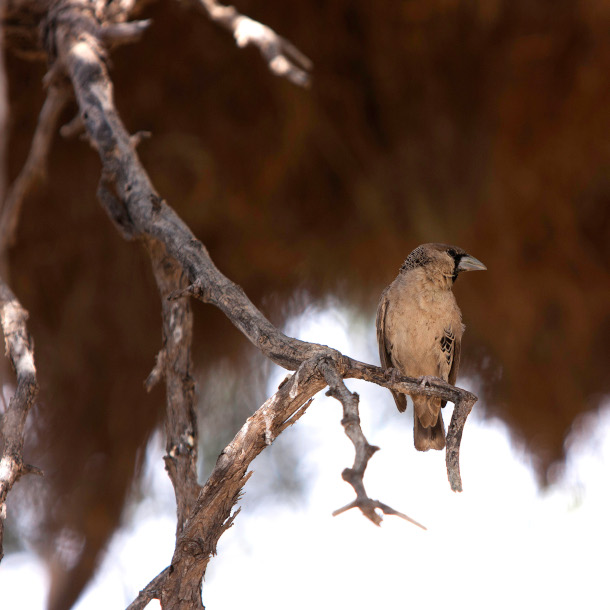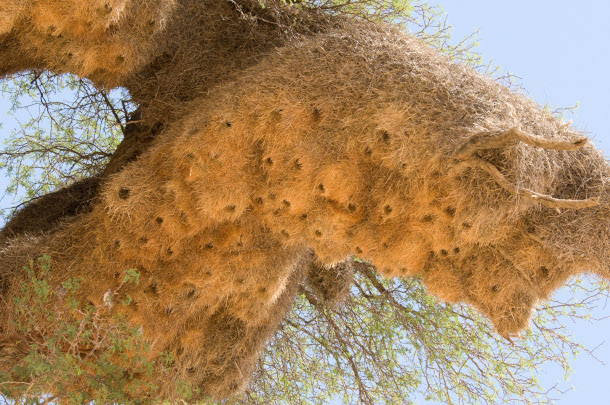BirdNote®: The Sociable Weaver’s Colonial Nest
Air Date: Week of April 8, 2022

Each bird family has a separate entrance into their own nest within the larger structure. (Photo: Sean van der Westhuizen, Flickr, CC BY-NC-ND 2.0)
What if birds lived in giant apartment complexes? Meet the sociable weaver from Africa’s arid plains, a species that does just that. As BirdNote®’s Michael Stein explains, these creatures build fascinating multi-unit nests that can house up to 500 birds.
Transcript
CURWOOD: It’s spring time here in the Northern Hemisphere and that means many birds must soon get down to the serious business of nesting. But as BirdNote’s Michael Stein reports, when it comes to building a nest the sociable weaver takes the cake.
BirdNote®
The Sociable Weaver's Colonial Nest
When it comes to nests, common sense would suggest that if you’re a big bird, you build a big one — a small bird, a small one. But in fact, some species of smaller birds build large nests. None, though, build anything like the huge, communal, structures of Sociable Weavers in southern Africa’s arid plains. These House sparrow-sized birds often live in accommodations with room for up to 500 birds.
[http://macaulaylibrary.org/audio/61174, use any parts in background]
Made from stiff grass, they’re relatively cool during the intensely hot day and relatively warm during the very cold night. A colony is made up of hundreds of individual nests clumped together. Attached to acacia trees or utility poles, they look like haystacks suspended above the earth. Each pair or family of Sociable Weavers has its own access hole and tunnel into a chamber within the larger complex.
Some structures have persisted for more than 100 years, with constant occupation by succeeding generations of Sociable Weavers.
One drawback of these nest structures is their weight: up to a ton when dry, even more when wet. They’re so heavy they can break their supporting branches and go crashing to the earth below.
I’m Michael Stein.

Sociable weavers’ nests, which can last for over a century, are home to generations of bird families. (Photo: Jeppestown, Flickr, CC BY-SA 2.0)
###
Written by Bob Sundstrom
Bird sounds provided by The Macaulay Library of Natural Sounds at the Cornell Lab of Ornithology, Ithaca, New York. Social Weaver [61174] recorded by Linda Macaulay.
BirdNote's theme music was composed and played by Nancy Rumbel and John Kessler.
Producer: John Kessler
Executive Producer: Dominic Black
© 2016 Tune In to Nature.org March 2016 / 2021 Narrator: Michael Stein
ID# SOCWEA-01-2016-03-29 SOCWEA-01
https://www.birdnote.org/listen/shows/sociable-weavers-colonial-nest
CURWOOD: For photos migrate over to the Living on Earth website, loe dot org.
Links
YouTube | ”Weavers Build Huge Communal Nests in Kalahari”
Audubon | “Africa’s Social Weaverbirds Take Communal Living to the Next Level”
Living on Earth wants to hear from you!
Living on Earth
62 Calef Highway, Suite 212
Lee, NH 03861
Telephone: 617-287-4121
E-mail: comments@loe.org
Newsletter [Click here]
Donate to Living on Earth!
Living on Earth is an independent media program and relies entirely on contributions from listeners and institutions supporting public service. Please donate now to preserve an independent environmental voice.
NewsletterLiving on Earth offers a weekly delivery of the show's rundown to your mailbox. Sign up for our newsletter today!
 Sailors For The Sea: Be the change you want to sea.
Sailors For The Sea: Be the change you want to sea.
 The Grantham Foundation for the Protection of the Environment: Committed to protecting and improving the health of the global environment.
The Grantham Foundation for the Protection of the Environment: Committed to protecting and improving the health of the global environment.
 Contribute to Living on Earth and receive, as our gift to you, an archival print of one of Mark Seth Lender's extraordinary wildlife photographs. Follow the link to see Mark's current collection of photographs.
Contribute to Living on Earth and receive, as our gift to you, an archival print of one of Mark Seth Lender's extraordinary wildlife photographs. Follow the link to see Mark's current collection of photographs.
 Buy a signed copy of Mark Seth Lender's book Smeagull the Seagull & support Living on Earth
Buy a signed copy of Mark Seth Lender's book Smeagull the Seagull & support Living on Earth

